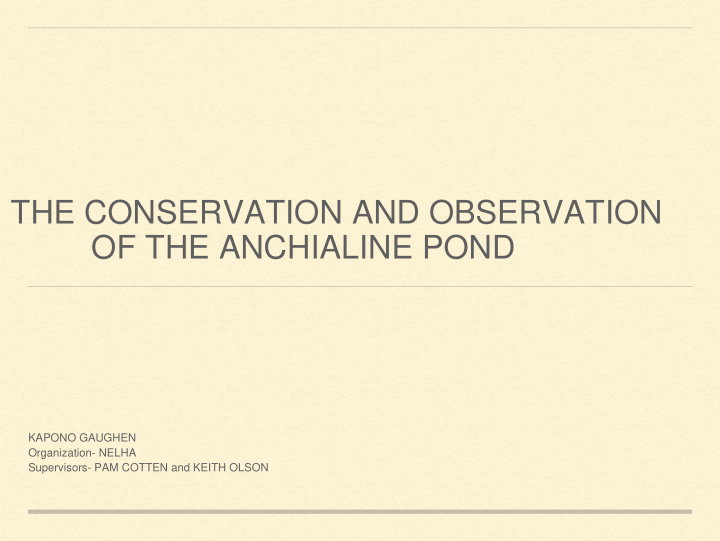



THE CONSERVATION AND OBSERVATION OF THE ANCHIALINE POND KAPONO GAUGHEN Organization- NELHA Supervisors- PAM COTTEN and KEITH OLSON
NELHA NELHA (Natural Energy Laboratory of Hawaii Authority) is dedicated to the creation of economically profitable and sustainable industry using sunshine, seawater and ingenuity. NELHA is located in central Kona and steward to 16 Anchialine ponds.
ANCHIALINE PONDS Anchialine ponds are land locked pools of water with a direct subterranean connection to the ocean. Micro-ecosystems diverse in indigenous and endemic life found only to the ponds. Home Native Shrimp, flys, mollusk, and plants.
Opae Ula Anchialine Pond
STATE OF THE ANCHIALINE PONDS Healthy ponds are filled with native shrimp ʻōpaeʻula, which keep algae in check. 95% of West Hawaii anchialine ponds are biologically degraded by exotic species. Ponds become overrun with algae, killing any remaining species, and fill with debris. 4 to 6 of NELHA ponds have exotic species present.
CHEMISTRY OF PONDS Due to sea connection, tidal effects on salinity, pH, dissolved oxygen, and temperature cause wide ranges. Research of this range and dynamics of the pond are limited. Knowledge needed to understand times of stress to native species, possible pond inhabitance, and future outlooks of the ponds.
PROBLEMS Chemistry is poorly understood, especially fluctuations involving the tide. Exotic biota are present in the ponds, resulting in the stress of the indigenous and endemic species. Maps do not exist for the public showing where the ponds are located on the NELHA campus.
PROJECT PURPOSE Part 1- Gather data on the relationship between tidal changes and the chemistry of anchialine ponds. Part 2- Remove invasive biota that is a stressor to native species. Part 3- Create maps which the public can use to locate the ponds.
WORK DONE SO FAR (CHEMISTRY) Data has been collected with the use of a moored in- situ CTD (Conductivity Temperature Depth)
TIDAL INTERACTIONS First 72 hr soak over a large tidal fluctuation looking for correlations between tide and pond chemistry.
SALINITY AND TIDE R= 0.6908
PH AND TIDE R=0.64 79
DO AND TIDE R=0.57 05
OTHER INTERACTIONS Sunlight appears to have effects on the chemistry of the ponds, complicating the tidal system on the ponds.
ALL TOGETHER Pond systems are complex!
IMPORTANT RANGES Temperature (C) 22.91 - 25.77 Salinity (Unitless) 13.14 - 17.31 Acidity (pH) 7.37 - 8.64 DO Concentration (mg/L) 0.02-12.59 Correct? New data recently collected.
WORK DONE SO FAR (INVASIVE SPECIES MANAGEMENT) Many ponds have been invaded by Mosquito Guppies. Literature on conservation studies provided simple and cheap way to remove Guppies. Tested different times of trapping, trap soak time, positioning, and different bait types.
BEST TRAPPING TECHNIQUES Time of catchment 8am-10am. Soak time- 2 hrs. Bait bread. Positioning, top portion of water column, in shade.
CATCHMENT SO FAR 1035 Individuals removed from ponds!
WORK DONE SO FAR (MAPPING) Mapping has been done with the use of Google Maps, real world measurements, and photoshop. Most maps now complete, or near so.
FUTURE OUTLOOK Chemistry of ponds can be used to predict biota capable of colonizing ponds, allowing for preemptive planning. Data of other ponds yet to be analyzed will yield clarity. Continuation of trapping, every day to every other day from 8am to 10am will eventually result in guppy population extinction. Maps can be used in future public outreach projects.
THANK YOU!
Recommend
More recommend